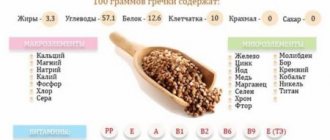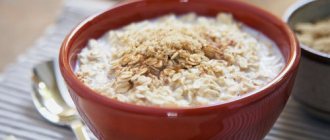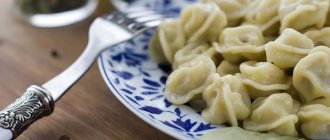The basis of the diet for inflammation of the pancreas consists of cereal dishes. The recommended products include semolina porridge: for pancreatitis, such food not only does not harm, but also has a beneficial effect on the digestive system. To get as much benefit as possible from eating semolina, you must follow several important rules regarding the introduction of porridge into your diet.
The basis of the diet for inflammation of the pancreas consists of cereal dishes.
Beneficial properties for illness and how it can harm
Semolina is finely crushed wheat. The finished porridge has a delicate consistency and does not irritate the mucous membrane of the inflamed pancreas. This important property makes a semolina dish an indispensable product in a diet that involves mechanical sparing of the gastrointestinal tract during pancreatitis.
Once in the gastrointestinal tract, this product gently envelops the walls of the digestive organs, reduces inflammation and promotes the removal of harmful substances, fats and mucus.
In addition, semolina helps eliminate diarrhea, which is often observed with pancreatitis.
The dish satisfies hunger well and is easily digestible; it does not cause heaviness in the stomach, bloating or pain due to its low fiber content.
Semolina porridge contains a lot of protein, which accelerates the restoration of pancreatic tissue during pancreatitis and normalizes its functioning. And although today it is increasingly argued that this product is the least healthy of all cereal dishes, we must not forget that semolina contains a number of macro- and microelements vital for humans, most of which are necessary for the normal functioning of the digestive system. These are B vitamins, tocopherol, zinc, magnesium, cobalt, potassium and some other trace elements.
Semolina contains B vitamins.
When properly prepared and following all recommendations for consuming semolina porridge, this product does not harm the body of a person suffering from pancreatitis. A negative reaction can occur in those rare cases when the patient has gluten intolerance. The large amount of calories contained in semolina does not affect the health and weight of a person’s body, because in case of pancreatitis, semolina porridge is introduced into the diet infrequently and in moderate portions.
What can you eat if you have inflammation of the pancreas?
The more approved types of cereals are consumed for pancreatitis, the faster and more effective the recovery process is. However, day after day, eating only such dishes over time becomes simply unbearable and begins to cause rather unpleasant sensations.
It is absolutely impossible to exclude them from the diet, since they are irreplaceable, and therefore you should show a little originality when preparing them. The first weeks after an exacerbation of the disease are the most difficult, and therefore experimentation is strictly prohibited. But over time, when new foods can be introduced into the diet, it is worth starting to combine.
Semolina is the finest and highest quality grind of wheat. It is not surprising that all dishes prepared from it are characterized by a particularly soft consistency. Due to the fact that the benefits of semolina have been talked about for a long time, it was allowed to eat it almost every day. But modern experts often express doubts about the beneficial properties of semolina. So is it possible to have semolina porridge for pancreatitis?
Semolina porridge is distinguished not only by its delicate consistency, but also by its speed of preparation. At the same time, it does not have an irritating effect on the human stomach and is perfectly absorbed due to its digestion.
Due to the fairly high protein content in its composition, it ensures a faster restoration of the structure of the pancreas, as well as its functions, so semolina can be useful for pancreatitis. But you can eat it only during periods of remission, and not during exacerbations.
What are the benefits of rice?
Features of use
To prepare porridge, semolina made from durum wheat should be used.
This dish should not be made the basis of the diet, because semolina contains an insufficient amount of nutrients, and the menu for pancreatitis should be nutritious and complete, despite strict restrictions.
In acute form
In case of acute pancreatitis, semolina porridge can be introduced into the diet immediately after the end of therapeutic fasting. The dish should be prepared in water without the use of oil, sugar or other additives. As you recover during cooking, you can add milk to the semolina, diluting it with water in a 1:1 ratio. You should start eating the dish with 1-2 tbsp. l. per day, gradually increasing the daily portion to 200 g.
- Porridges for gastritis with high acidity: oatmeal, rice, pearl barley
In the chronic stage
In case of chronic pancreatitis, outside the period of exacerbation, the diet of a sick person expands significantly. Semolina porridge can be cooked in milk with a fat content of no more than 3.2%; butter and sugar can be added. The maximum daily portion is 200 g, and it is not recommended to include semolina in the menu more than three times a week.
In case of chronic pancreatitis, outside the period of exacerbation, the diet of a sick person expands significantly.
During exacerbation of the disease
In case of exacerbation of chronic pancreatitis, semolina can be used in the diet already on the third day after the attack occurs. Porridge should be cooked in water or milk, strongly diluted with water; adding butter and sugar is excluded.
During remission
During stable remission of pancreatitis, you can eat semolina porridge with milk, butter and sugar. It is also allowed to add honey, jam, sweet fruits and berries, which are allowed for chronic inflammation of the pancreas. During this period, semolina can be used to prepare cutlets, savory baked goods (mannikas), casseroles, mousses and other dietary dishes.
10-15 days after the attack is over, you are allowed to eat dishes made from steamed or boiled veal. During the period of remission, it is useful to eat semolina mousses. Semolina cutlets are also useful during the period of remission.
Hercules porridge
In order to slightly diversify the menu that should be followed during inflammation of the pancreas, you can and even need to include rolled oats in it. Its main trump card is the content of many useful elements that are so necessary for the human body.
It is worth noting that it is a universal food not only for diseases of the digestive system, but also in a daily healthy diet. It is considered to be the main element in proper nutrition, since oatmeal stabilizes the activity of the pancreas, satisfies hunger, gives strength and helps strengthen the immune system.
Hercules porridge for pancreatitis not only gives a person the energy needed to fight the disease, but also helps relieve pain. Her recipe is very simple:
- Boil two glasses of water in a saucepan.
- Add one glass of cereal, a little salt and sugar. Cook the porridge for about 15-20 minutes.
- The finished dish should sit for 5 minutes, after which you can add a little oil, honey or fruit.
However, you should not get too carried away with this dish. You should eat it in small portions, but about 5 times a day. Thus, the functioning of the pancreas is normalized faster.
Recipes for preparing semolina porridge for pancreatitis
You can prepare semolina porridge for therapeutic nutrition for pancreatitis in the following way:
- Mix a quarter cup of cereal with 100 ml of water.
- Pour 1 glass of milk diluted with the same amount of water into a saucepan, bring to a boil, add a pinch of salt and 1-2 tsp. Sahara.
- With constant stirring, pour the semolina combined with water into the pan and boil for 2 minutes, continuing stirring.
During the period of remission, the finished dish can optionally be supplemented with 5 g of butter or 1-2 tsp. honey, jam, fresh bananas, apples. In the absence of exacerbations of pancreatitis for a long time, cereals can be cooked only in milk, without adding water (for 60 g of semolina, 500 ml of low-fat milk).
All kinds of cereals often become the basis of the diet of patients with pancreatic disease. Nutritional value, pleasant taste, and easy digestibility make the dish a leader in food consumed by patients with the disease. Not all cereals are equally useful for pancreatitis.
Pumpkin porridge
One of the best porridges in the daily diet is pumpkin porridge. In addition to its pleasant taste, it, first of all, has healing properties. Its main advantage is its easy absorption by the body, which is greatly weakened at this time.
Due to its material composition, it acts as a neutralizer of hydrochloric acid, which by its nature is a stimulating tool for pancreatic secretion. In addition, pumpkin itself has a fairly small percentage of fiber.
Pumpkin porridge for pancreatitis is a combination of pumpkin and rice, cooked in water.
- Approximately 700-800 grams of pumpkin pulp are cut into small cubes, placed in a saucepan and poured with two glasses of water. If your doctor allows you to include milk in your diet, porridge can be prepared with a mixture of milk and water.
- The vegetable should cook for about 7-10 minutes.
- Then add 100 grams of washed rice cereal, as well as a little sugar and salt, to the pan, cover with a lid and leave over moderate heat.
- In about 20-25 minutes the dish will be ready.
This dish must be consumed warm, since the temperature of the food plays an important role in nutrition.
With the permission of the doctor, pumpkin porridge for pancreatitis that has left the exacerbation period is supplemented with a small amount of butter. If allowed, you can add refined vegetable oil, the main condition in both cases is that the oils must be unsalted.
Semolina in the patient's diet
Semolina is carefully crushed wheat. Food prepared with the addition of cereals has the most delicate taste, soft mucous structure, and does not require additional grinding. Semolina is quickly absorbed, provides a feeling of satiety, and easily coats the walls of the esophagus, preventing irritation. Porridge occupies a leading place in the treatment of the inflammatory process in the pancreas.
- Corn porridge for constipation
The benefits of semolina
Semolina for pancreatitis exhibits a number of useful qualities:
- The structure is not rough, which is important during the inflammatory process.
- When boiled, it acquires a slimy consistency. By covering the walls of the esophagus, it prevents the penetration of pathogenic microbes to the source of the disease, and helps remove excess mucus and fatty substances from the body.
- It contains a lot of protein, which has a beneficial effect on the healing process of the disease.
- Does not contain plant fibers, preventing the occurrence of excessive gas formation.
- Semolina is filled with useful substances that are preserved in their original form during heat treatment.
Harmful qualities of semolina
The cereal contains gluten and phytin, which are harmful to babies and interfere with the accumulation of calcium in the body. For patients with inflammation of the pancreas, the substances are harmless; semolina is not considered the main source of nutrition for an adult.
As for the abundance of calories in semolina: a small amount of cereal is needed to prepare the dish; calorie counting will not play a decisive role.
Semolina during exacerbation of the disease
Semolina spread in water is the first dish a patient is allowed to eat during an exacerbation of the disease. Already a couple of days after the incident, the semi-liquid consistency in its pure form is allowed to be taken by the patient in minimal doses. By the end of the first ten days of the disease, it is allowed to eat semolina in the form of dessert, soup, or use it as an additional component in minced meat dishes.
Semolina during the period of attenuation of pancreatitis
During the period of decline of the disease, other dishes made from semolina are added to the patient’s diet: sweet porridge, soups seasoned with semolina products, manna. Cottage cheese casseroles with the addition of semolina are welcome. Baking and adding to minced meat and fish are allowed. Semolina is allowed to be eaten once every two days, replacing it with healthier cereals in the menu.
Oatmeal
For pancreatitis, oatmeal, like any cereal products, should be consumed in moderation. The advantage of oatmeal is that it controls cholesterol levels and enriches the body with essential vitamins and minerals.
Secrets of eating oatmeal.
- Oatmeal contains a large amount of fiber, so in the first days after an exacerbation of the disease we do not eat oatmeal at all.
- When consuming oatmeal during an exacerbation, it is better to grind it literally to the state of flour. To add extra flavor, you can add cereal flakes to oatmeal, but in very small quantities.
- With such inflammation, it is strictly forbidden to prepare dishes from whole oatmeal grains, as well as from those that have not been processed.
Porridges included in the diet of a patient with pancreatitis
Porridges are dishes that add variety to the patient’s poor menu. The following will be beneficial: porridge made from rice, oatmeal, buckwheat, barley. They will cause harm - from millet, corn, wheat, peas, lentils and chickpeas.
Rice porrige
The first porridge consumed after an exacerbation will be rice. The polished cereal is boiled over low heat using water or diluted milk in the proportion: a liter of water and rice. When the disease subsides, the finished cereal takes on a free-flowing appearance; it is allowed to add salt, butter, and granulated sugar.
Rice porridge is healthy: it is rich in nutrients, prevents hunger, and can be easily digested. The dishes do not irritate the digestive system and carefully cleanse the body of waste products. Rice porridge exhibits an enveloping effect that protects the walls of the esophagus from irritants.
Due to its high fixative ability, porridge is not recommended for consumption in case of constipation - a frequent companion to inflammation of the pancreas.
Oatmeal
Oatmeal is considered a mucous porridge. Famous for its enveloping qualities, it is well accepted by the body, quickly absorbed in the gastrointestinal tract, saturating the body with proteins and fatty acids. Porridge neutralizes the excess of enzyme substances that occur during pancreatitis, has a stimulating effect on the digestive system, and is indispensable for difficulties with peristalsis.
- Buckwheat for gastritis - Is it possible to eat buckwheat and is buckwheat porridge necessary?
Buckwheat
Buckwheat showed the highest score among porridges in terms of the composition of vitamins, minerals and energy benefits. The content of a large number of cellular fibers increases the effectiveness of intestinal cleansing and makes the body resistant to a number of pathogens. Buckwheat helps regenerate pancreatic cells and relieves inflammation in the gastrointestinal tract. The porridge contains few calories and is indicated for consumption from the first hours of pancreatitis. Buckwheat plays a cleansing, stimulating, enzyme-generating role and improves pancreatic functionality. With any type of cereal grinding, the usefulness does not decrease. This makes buckwheat porridge the first choice for illness.
During an exacerbation of the disease, it is necessary to consume buckwheat, boiled until sticky. Oil and salt are prohibited. When the patient’s condition improves, the patient is allowed to take pre-chopped buckwheat soup. At the moment of attenuation, it is allowed to consume buckwheat in crumbly form. You can add butter, sugar or bee products. Buckwheat, diluted with kefir, has a cleansing ability that restores the functioning of the pancreas.
Barley porridge
Barley plays an important role in pancreatitis, exhibiting the ability to remove toxic substances, envelop the mucous surface of the esophagus, relieve pain, relieve inflammation, creating a protective coating for the intestines.
The downside of cereal is its excessive hardness. For the purpose of normal digestion, it is necessary to cook the cereal for a long time and then rub it through a sieve.
Wheat and barley porridge
Cereals contain a lot of gluten, vitamin B, potassium and other useful substances. The composition of the cereal is low in calories.
Wheat porridge for pancreatitis improves metabolism and the functioning of the digestive tract, removes negative elements from the human body. Due to the extreme carbohydrate content in pancreatitis, millet is consumed in limited quantities, in small portions and infrequently.
Barley porridge is prohibited. The reason was an excess of carbohydrates, which causes difficulties with digestion. Barley porridge can be eaten in the form of puree during the complete attenuation of the disease and infrequently.
Millet for pancreatitis
Millet porridge for pancreatitis is allowed for infrequent consumption during the decline of the disease. Millet with pancreatitis is not digested by the human intestines, creating a large load on the diseased pancreas.
Corn and bean porridge
Corn does not lose its hardness even after boiling for a long time. The fiber contained in the composition creates great difficulties with digestion. Including corn in the diet is indicated for indolent forms of the disease and is extremely rare.
Peas, chickpeas, and beans contain an increased amount of coarse fiber, which causes flatulence and other unpleasant symptoms. Porridges from the listed crops are prohibited, even during relief of the disease. On rare days of consumption, you are allowed to cook such porridges infrequently, eat a little at a time, chewing thoroughly.
What cereals are prohibited
If you have pancreatitis, you should not include the following cereals in your menu:
- Millet. It is rich in carbohydrates and is a fairly heavy product; the body spends a lot of calories processing it.
- Wheat cereals, corn and legumes can increase acidity and cause heartburn and bloating.
- Bran is prohibited for pancreatitis, as its coarse fibers can injure the diseased organ. It is undesirable to eat bran even at the stage of remission.
During treatment, you should adhere to all recommendations and clearly know which products will be useful and which should be avoided.
How to cook?
For pancreatitis, the allowed porridges are tasteless and bland. During an exacerbation nothing can be done to help. When the disease subsides, additives in the form of: butter, granulated sugar, bee products, jam, berries, fruits, dried grapes, nuts, seeds will help improve the taste a little.
The place where the porridge is prepared is of great importance. Dishes turn out well in the oven and special eclectic utensils for cooking porridge. A delicious side dish of vegetables, meat and fish products, light sauces and dressings will help improve the taste.
Porridges bring great benefits to the body with pancreatitis. Each has pros and cons, certain properties and disadvantages. For proper nutrition, you cannot limit yourself to one type of food; the diet must be varied. It is better to eat porridges one at a time, using original cooking methods and adding various ingredients.
Is semolina harmful for pancreatitis?
- Dishes made from semolina have a very delicate structure, which is important during a diet with mechanical sparing.
- Boiled semolina, moving through the intestines, gently envelops its walls, absorbs and removes mucus and fats.
- Semolina contains quite a lot of protein - about 10 g per 100 g of cereal, and a diet for pancreatitis involves enriching the diet with protein to quickly restore the structure and function of the pancreas.
- There is practically no fiber in semolina, so dishes made from it do not cause bloating, flatulence, spastic colic and other unpleasant symptoms. Semolina is also recommended in the presence of diarrhea syndrome due to pancreatitis.
- Semolina also contains other important components - carbohydrates, vitamins (mainly from group B, some microelements). Due to the fact that semolina dishes take only a short time to prepare, most of the vitamins in them are retained.
One can only talk about the harmful properties of semolina in relation to children, and even then of infancy. It is for them that the high gluten content in semolina and the presence of phytin, which interferes with the absorption of calcium and reduces its content in the child’s bones, are dangerous. For adults, gluten and phytin do not pose a danger, if only because semolina is not the main or only food for them. For the same reason, the low (compared to other cereals) content of vitamins in semolina is not particularly important.
Regarding the frequently encountered statement about the high calorie content of semolina (about 330 kcal), it should be noted that most of the popular dishes made from it (porridge, soups, casseroles) contain very little grain. And the calorie content of the same 100 g of semolina porridge cooked in water no longer exceeds 100 kcal.
Dishes made from semolina, namely liquid semolina porridge, cooked in water or half and half with milk, are one of the first to appear in the diet of a patient who has suffered an attack of pancreatitis. In the absence of vomiting, porridge can be consumed already 2-3 days after the onset of an exacerbation, starting with 1-2 tsp. Of course, porridge cannot be seasoned with either butter or sugar.
By the end of the second week of the acute period of the disease, other semolina dishes are introduced into the patient’s menu - semolina pudding, soups with semolina, semolina can be added to minced meat to make cutlets and quenelles.
During stable remission, the range of semolina dishes becomes even wider: semolina porridge in milk with the addition of sugar, jam and butter is allowed; Dumplings for soups, puddings, soufflés, mousses, jelly, casseroles, savory pies (mannika) and cookies are prepared from semolina; bake (but do not fry) pancakes; semolina is used to add to minced meat and fish.
However, semolina should not be used in the diet too often; it is not suitable for the daily menu during remission, since the content of necessary vitamins, micro- and macroelements in it is still insufficient. It is recommended to include semolina dishes (various) in the diet no more often than every other day.
Ingredients
- semolina (quarter cup);
- milk (glass);
- water (one and a half glasses);
- sugar, honey, jam, butter (to taste).
- First, mix the cereal with half a glass of water and set aside.
- Pour a glass of water and milk into the pan, stir. Bring to a boil.
- Remove the container from the heat and add the soaked semolina in a slow, thin stream, stirring constantly with a spoon - this will help avoid the formation of lumps.
- Place the porridge on low heat and cook for just a couple of minutes, continuing to stir.
When the semolina is ready, add butter to taste and sweeten. Not only sugar works with this, but also jam and honey.
Liquid semolina porridge with milk and half and half water can be introduced into the menu already from the 4-5th day of illness.
During an exacerbation, semolina with diluted milk is allowed 4 days from the start of the attack. From 3-4 weeks you can add a piece of butter to the porridge. During the period of remission, semolina porridge can be cooked only in milk, without diluting with water, and seasoned with butter, sugar, honey or jam.
The harmful properties of this cereal can only be discussed in relation to children, and only infants. It is for them that the composition of semolina porridge is dangerous, which can interfere with the normal absorption of calcium.
Semolina porridge has beneficial properties for patients with pancreatitis:
- The delicate enveloping texture of the product is important in the treatment of the digestive organs due to the absence of mechanical damage.
- Contains special substances that remove mucus and fats.
- Thanks to its protein content, it helps restore the function and structure of the pancreas.
- Since such cereals contain a small amount of fiber, they do not cause bloating, flatulence and colic.
- It is a storehouse of vitamins and microelements. All of them are preserved in the product, because the cereal does not need to be cooked for long.
There can be no harm from semolina for pancreatitis. Only negative effects have been proven in relation to infants due to the presence of gluten and phytin in semolina, which negatively affect the absorption of calcium by the child’s body.
More recently, semolina porridge was the most popular porridge in many republics of the former USSR. Many medicinal and nutritional properties were attributed to it, it was prescribed to patients with ulcers or gastritis, with the help of semolina they restored strength after serious illnesses, it was in the diet of almost every elderly person or child. Now this dish has become a rarity on our table.
Compound
Semolina is equal in composition and properties to premium flour. Its composition is a combination of saturated fatty acids, fats, proteins and carbohydrates, starch (almost 70%) and gluten, saccharides, fiber, ash, and dietary fiber. Semolina contains a set of vitamins (B1, B2, B6, B9, PP, E) and minerals (magnesium, calcium, phosphorus, sodium, iron, sulfur, chlorine, zinc).
The composition of semolina is a combination of easily digestible components that are designed to provide the body with a supply of nutrients with maximum absorption capacity in the shortest possible time. If we compare semolina with other cereals (buckwheat, oatmeal, rice), then it will lose to them in the amount of vitamins and microelements by 3-5 times.
Calorie content of semolina
The calorie content of semolina porridge is approximately 123 kilocalories per 100 grams of the finished dish. In dry form, the calorie content of semolina is 326 kilocalories. The calorie content of this porridge is also quite high because high-calorie additives such as fat milk, sugar and butter are usually used to prepare semolina.
When cooking porridge in water, with a minimum amount of vegetable fat, the calorie content of the finished dish will be low. For example: when preparing porridge with milk, it will give the body as much as 100 kcal, but if you cook semolina in water, it will only contain 80 kcal.
Why children should not often eat semolina porridge:
- phytin contained in semolina interferes with the absorption of calcium, which can lead to blood clotting disorders, heart problems, and seizures;
- gluten content leads to allergic manifestations and disturbances in the gastrointestinal tract;
- iron absorption is impaired, leading to iron deficiency anemia.
Semolina porridge with milk and water 1:1 is used for pancreatitis. For acute pancreatitis, it is used starting 4-5 days after the onset of the attack. For chronic pancreatitis, semolina in a 1:1 ratio of milk and water is used from 4 days from the onset of the attack. It is permissible to add butter no earlier than 3 weeks from the onset of the disease. During the period of remission and absence of attacks, semolina for pancreatitis can be used with whole milk with the addition of sugar, butter or jam.
The benefits of semolina porridge for patients with gastritis are undeniable. It envelops the stomach, cleanses the digestive organs of toxins and waste, and heals microtraumas of the stomach and intestines. Semolina porridge is an excellent prevention of malignant degeneration of erosions and ulcers, especially for the elderly. Semolina porridge for gastritis is prepared in water, with minimal addition of salt and sugar. During an exacerbation, sugar and salt are not added to semolina porridge at all.
Semolina porridge for diabetes (especially gestational diabetes) is not recommended for consumption. Let's figure out why this is and what harmful effects it has. Semolina porridge has a high glycemic index and causes you to quickly gain unwanted excess weight.
When eating semolina, insulin is produced poorly, which contributes to high glucose levels. Therefore, semolina porridge is not a dish recommended for diabetics. People with diabetes-related complications should especially not consume this dish frequently. If you use this porridge occasionally, in small doses, then it will not bring much harm to patients with diabetes.
Buckwheat
Perhaps the most popular and popular porridge is buckwheat. It is especially preferred due to its pleasant taste and appetizing appearance.
In addition, it has an impressive composition of vitamins, microelements, amino acids and minerals, which are needed not only during illness, but also for a healthy body. However, it should be used only from the 5th day.
Buckwheat in its original form is not particularly soft, and therefore, first you need to carefully sort it out, then rinse it several times.
- The prepared cereal is poured with boiled warm water and left to swell for 15-20 minutes. This will make it softer.
- Water is poured from the cereal, washed and transferred to a saucepan.
- Buckwheat is poured with boiling water at the rate of 1 part cereal to 2 parts water, add a pinch of salt and sugar.
- The porridge is cooked over low heat until cooked and the water has completely boiled away.
Its main advantage is vegetable protein, which is quite easily digestible. Buckwheat porridge for pancreatitis is the most important and simply irreplaceable item in the general menu and, with a rational approach to consumption, has an almost complete absence of contraindications.










